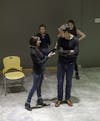Interview with Nate Rtishchev ’21
JustArts: What was your previous directing experience before Godspell?
Use the field below to perform an advanced search of The Justice archives. This will return articles, images, and multimedia relevant to your query.
JustArts: What was your previous directing experience before Godspell?
“Outlaw King” is a historical drama about the journey of the legendary king of Scotland, Robert the Bruce. Robert, facing the British, one of the strongest armies in Europe, who had already defeated the Scots before, needs not only to find a way to victory but also to be a leader for a discouraged and restless nation. The film is directed by David Mackenzie, who was praised for his 2016 Western crime drama “Hell Or High Water,” my favorite film of that year. For that reason, I was looking forward to “Outlaw King,” Mackenzie and Pine’s second collaboration.
To rubberneck is to get a better view of an accident out of morbid curiosity as you pass it by. Last week in the Shapiro Campus Center Theater, you might say I was rubbernecking. From Nov. 15th-18th, the Undergraduate Theater Collective produced “Godspell,” directed by Nate Rtishchev ’21. The 1971 musical was written by John Michael Tebelak, with music by Stephen Schwartz. It is structured as a series of parables based on the Gospel of Matthew, with lyrics borrowed from traditional hymns.

WATCHING GOD: Standing on a classroom desk, Alina Sipp-Alpers ’21 gazes wistfully out into the audience.


HOLY SPIRIT MOVES: Godspell characters brought sharp choreographed movements and large amounts of energy.

DANCING TO HEAVEN: The dance moves of these Godspell cast members perfectly matched the music’s tempo.

ANXIOUS EYES: Lauren and Marty, played by Noa Laden ’20 and Zack Garrity ’20, share a nervous glance as they sit in a circle on the floor of the studio.

HULA SKILLS: Theresa (Haia Bchiri ’20) effortlessly displays her hula hooping prowess.

LEARN IN MOTION: Marty (Emily Pollack ’21), the eccentric drama teacher, proves an enthusiastic and hands-on instructor.

BRIEFLY IN LOVE: Theresa and Schultz (Peirce Robinson ’22) share an intimate moment during their fleeting romance.

FOREVER IS OUR TODAY: A vintage photo of Freddie Mercury performing live in San Diego in 1980, provocatively dressed in nothing but bellbottoms and a neck tie.

FESTIVAL VIBES: A glamor shot of Chris Pine, who plays Robert the Bruce in “Outlaw King,” taken at the 2018 Toronto Film Festival.
Artists Anne Lilly and Karin Rosenthal unveiled their new collaborative exhibit, comprised of Rosenthal’s stunning photographs and Lilly’s impactful sculptures, at Brandeis’ Women’s Studies Research Center on Thursday. The photographs focused on the naked human body — often in extreme close-ups — incorporating water to obscure certain body parts. Two of the four stainless steel sculptures also dealt with the human body and obscuring vision, interacting with the viewer and their body.
I never thought there would be bubbly energy in my biochemistry classroom. Everyone sitting in the audience was ready to have a good time as members of Brandeis’ improv troupe, To Be Announced, walked in along with the members of Bad Grammer in their joint show “Brains vs. Brawn.” While I wouldn’t normally agree to being in a science building more than I have to, I’m glad I did last Saturday. In all my time at Brandeis I’ve never attended an improv show, so I was anticipating something fun and new.
—Editor’s note: Nia Lyn ’19 performed in Night for Africa. She did not take part in editing this article.
This week, justArts spoke with Rachel Moore ’19 and Akshiti Todi ’19, co-presidents of the Adagio Dance Company.

WOMEN IN COMEDY: Abby LeRoy ’20 and Lena Burdick ’21 showed off their respective comedic abilities at TBA’s show last semester.

THROWBACK: Caroline Kriesen ’20 advises Seneca Scott ’20 to internalize all of his problems in a skit from last year’s showcase in Ridgewood A Commons.
